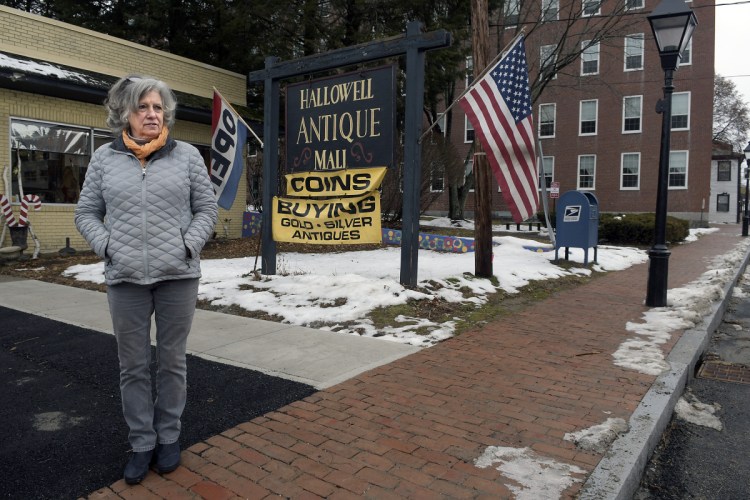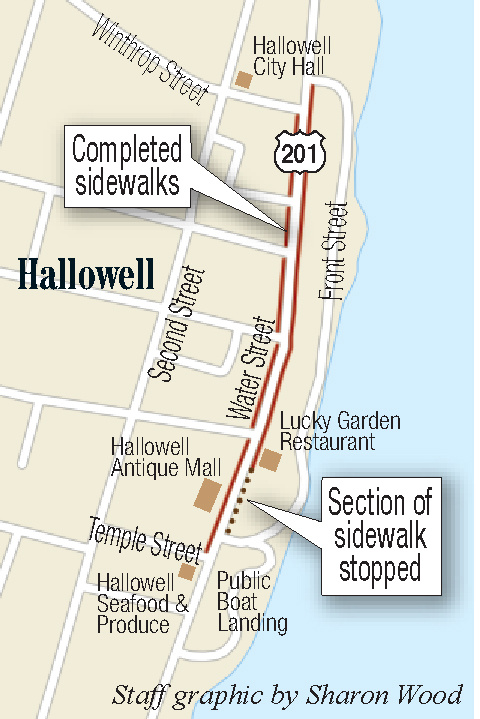HALLOWELL — Why did Hallowell’s sidewalk expansion stop short of its planned route?
The answer has been an elusive one, with state and city officials pointing at the other for ending the extended sidewalk prematurely.
To gain greater insight into the process that led to the sidewalk expansion stoppage, the Kennebec Journal issued a Freedom of Access Act request for documents pertaining to the meeting. Through a review of communications between city and state officials, and a series of interviews, the picture of how the project’s end came to be has become clearer.
The original plan was for the sidewalk to be extended down both sides of Water Street in Hallowell’s downtown, south to the boat landing. During the process, however, owners of the Lucky Garden restaurant at 218 Water St., Annie and Tony Huang, raised an objection to the sidewalk being built in front of their property, as it would have required moving boulders that rest next to the restaurant’s parking lot.
After a meeting of the Huangs and state and city officials, the resolution was that the sidewalk would end where the boulders begin.
The sidewalk stoppage irked some local residents, though, who asked why it had stopped.
Mercedes Knee, owner of the Hallowell Antique Mall across the street from Lucky Garden, said she would have liked to see the sidewalk extend to the boat landing, though she was happy with the overall quality of the project. Knee said she asked DOT representatives for a wider driveway on her property when she reviewed preliminary plans. She said department representatives told her it could not change becaue of a width standard.
“I asked every time that we saw the plans if we could make the driveway wider, but it wasn’t a fight,” she said. “We didn’t make a fuss about it. We’re not fussy people.”
Jon Lund, a former Maine attorney general who owns a sliver of land between the restaurant’s parking lot and the boat landing, told the Kennebec Journal in October that he was disappointed that no sidewalk was being built after DOT purchased a small part of his land.
“I accepted (the DOT offer) with the expectation of having a sidewalk running through my property,”he said.
Former Councilor Alan Stearns said he thinks the halted sidewalk flies in the face of previous council action. The sidewalk extension was mentioned in a 2014 cooperative agreement between the city and DOT. It was referenced vaguely later in a 2016 City Council resolution that allocated up to $483,762 to a number of tasks. Both documents have language that left them open to alterations, according to a Kennebec Journal review.
Stearns said those documents did not demand the sidewalks in their wording, but the “culture and spirit” of the documents were to include them.
“There is certainly flexibility anticipated in (those documents),” he said. “The culture and spirit of everything the council did was premised on public participation, thorough council briefing and council unanimity.”
HOW SIDEWALK ENDED
At 4 p.m. March 21, DOT Project Manager Ernie Martin, DOT Manager of Legislative and Constituent Services Meghan Russo, Lucky Garden owners Annie and Tony Huang, Rep. Charlotte Warren, Hallowell Mayor Mark Walker and City Manager Nate Rudy met to discuss the future of a rock formation that marks the end of the sidewalk on Water Street and separates the street from the restaurant’s dedicated parking lot.
The meeting was organized by Warren, who said she was helping the Huangs, her friends, because they were confused about two checks they received from DOT.
“I went to a meeting where I made sure my friends could understand what everyone was saying,” she said. “My biggest fear was that they would misunderstand and be on the hook for some money.”
After the meeting, Ernie Martin sent digital renderings of possible solutions to the Huangs on March 22. The Huangs told Martin on March 23 that they did not want to move the rocks. The next day, Rudy confirmed the decision.
“I’m disappointed that they chose what I think is the least elegant solution, but I accept that it is their decision to make and will support it/them,” Rudy wrote in an email.
Rudy said Monday that he confirmed the decision because he did not think the city had “any role” in negotiations. He previously had pledged to support the owners in a March 18 email, saying, “the City will not press the issue of the Lucky Garden parking area if the property owner is not willing to comply.”
On Thursday, DOT spokesperson Ted Talbot issued a statement saying that DOT acted after Rudy’s confirmation.
“In the days following the meeting, the owners expressed their preference to keep the existing condition which prohibited construction of the sidewalk,” he said. “After receiving the City Manager’s communication that he supported the owners’ decision, DOT removed the new sidewalk extension from the project.”
LACK OF AWARENESS
While the DOT said Rudy was the reason they didn’t follow through on the original plans, the city manager refutes the claim that he somehow made the ultimate decision on the project. He said he was unaware of decision-making protocol and, if he had been aware, he would have alerted councilors to the meeting. Rudy did not submit any documents that mentioned previous decision-making processes with the DOT, but said it usually routed its concerns through the Highway Committee. He refuted any claim that he somehow made the ultimate decision on the project.
“I take responsibility for being uneducated about the process at the time, but I was not driving this,” Rudy said. “I didn’t even know there was something to be confused about.”
When he became city manager in 2016, Rudy said, he was told his role was to “make sure the city was doing our part to help make sure the project got done.” He said he did not think that role included design portions of the project.
Even though councilors had voted on previous agreements, resolutions and changes pertaining to the Water Street reconstruction project, they did not do so with the sidewalk plan change. They reportedly were briefed vaguely about the sidewalk meeting at two City Council meetings, but they did not ask questions of city officials at the time of the briefings.
In March, councilors voted four times to move a crosswalk from Dummers Lane to Central Street. Rudy said the sidewalk plan alteration is of similar importance and probably should have gone to the Highway Committee or council for approval.
“My position is that they understood the process, they understood who the decision-makers were, they understood who needed to be contacted, and in every other situation — anytime there has been any substantial correspondence — DOT has always included the members of the Highway Committee,” he said. “For them to assert that, somehow, this time it was different, it doesn’t make sense to me.”
Martin said Friday that he did not approach the Highway Committee because the sidewalk was a city-commissioned project. He said he had contacted Councilor Lisa Harvey-McPherson, chairwoman of the Highway Committee, about other topics having to do with the project on the state’s side.
“They should have informed their own personnel,” Martin said. “I don’t control that.”
Harvey-McPherson told the Kennebec Journal that she was aware of the meeting between the Huangs and state and city officials after Walker briefed councilors orally in March and April. While the briefings were vague, she said the council did not raise questions or request more information.
“In March, we were consumed with the community interest in crosswalks; we had special meetings about crosswalks,” she said in October. “Then the project started, and we were concerned about the nature of starting that large project.”
When asked Friday if she thought a council action should have been taken on the decision to abandon the sidewalk, Harvey-McPherson said the briefings given by Walker in March and April were not detailed enough. He confirmed that the briefings were vague.
Harvey-McPherson said a more detailed briefing could have led to a larger conversation between councilors and citizens.
“In retrospect, I think that a high-level briefing — that an agreement had been reached — was not the level of detail that was helpful for the council,” she said.
Councilor Diano Circo, who was present for three of four meetings in March and April, did not recall a briefing during an October interview. He did not return multiple requests for comment for this report.
Councilor Lynn Irish said Oct. 24 that the Highway Committee would “like to see a sidewalk in there.”
A November meeting of the Highway Committee to discuss the details of the meeting was postponed. The next meeting of the committee will be Dec. 6 at 8 a.m.
APPEARANCE OF CONFLICT
Another issue that came up when questions were raised about the sidewalk stoppage was Walker’s prior legal representation of the Huangs. It was referenced in multiple email communications; Russo mentioned Walker’s “double role” in a March 18 email.
He clarified the relationship in a March 19 email chain with Martin, Rudy, Warren and Russo.
“For clear disclosure due to my double role, I told the property owners several months ago I could not represent them in this matter,” Walker wrote, “though I would seek clarification from the City and State as to what exactly was in the final design.”
He said that he was not on retainer for the Huangs but might help them file their annual reports to the secretary of state this year.
“It never (occurred) to me that it was an issue (to be at the meeting),” Walker said. “All of the parties knew that there was not a double role.”
He said he provided with the Huangs with information about the project in his capacity as mayor but never offered them legal advice on the topic. Walker added he would have done the same thing for any other resident who openly resisted construction.
Sam Shepherd — 621-5666
Twitter: @SamShepME
Send questions/comments to the editors.




